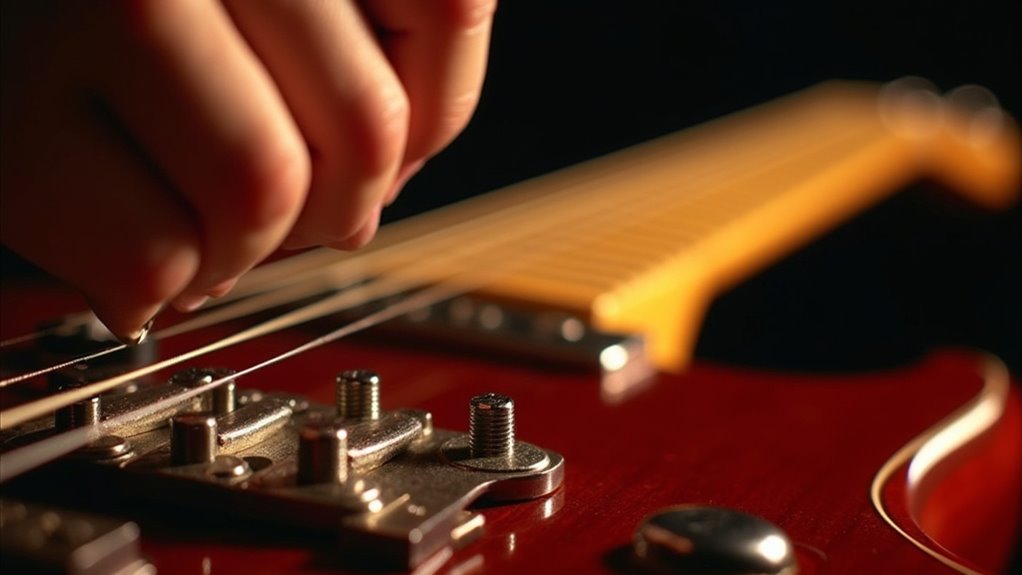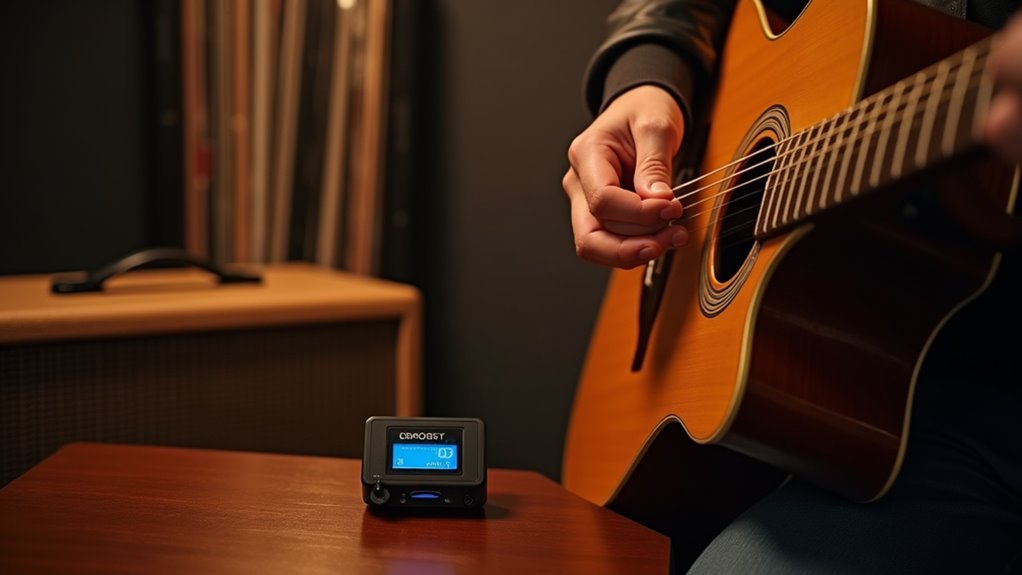A perfectly tuned guitar can still sound horrible if the intonation is off. We’ll show you exactly how to adjust your guitar’s intonation like a pro, even if you’ve never touched a saddle screw before. Let’s be clear: proper intonation isn’t just about making your instrument sound better – it’s about transforming your guitar from a source of frustration into a precision instrument. What follows will save you countless hours of wondering why your chords sound muddy.
What Guitar Intonation Means and Why It Matters

While many guitarists focus obsessively on tuning their strings, they’re often missing the bigger picture – proper intonation.
Let’s get this straight: guitar intonation is what makes your instrument actually play in tune across the entire fretboard. It’s all about adjusting the bridge saddle so your fretted notes match perfectly with your open strings, especially at the 12th fret.
Without proper intonation, you’re fighting a losing battle – notes will sound sharp or flat as you move up the neck.
We’ve seen countless guitar setup issues, but poor intonation is the silent killer of great tone. It’s especially tricky with acoustic guitars, where saddle adjustments aren’t as straightforward.
Environmental factors like temperature and humidity can throw your intonation off, so regular checks are non-negotiable for serious players.
Essential Tools for Adjusting Guitar Intonation
Now that you understand why intonation matters, let’s talk gear.
You’ll need the right tools to properly adjust your guitar’s intonation. Don’t skimp here – precision matters.
- An accurate tuner (preferably strobe-type) for detecting minute pitch variations
- Flathead screwdriver or Allen wrench for saddle adjustments – MusicNomad’s 26-piece set is perfect
- 1/4″ cable to connect your electric guitar to the tuner
- Fresh set of strings – old ones won’t cut it for precise intonation
- Nut slot lubricant to maintain tuning stability
These essentials guarantee you can make exact adjustments without guesswork.
The right tools make all the difference between a properly intonated instrument and one that’s perpetually out of tune. Trust us – you’ll hear the difference.
Checking Your Guitar’s Current Intonation

Let’s dive straight into checking your guitar’s intonation – it’s not as complex as you might think. Start by tuning your guitar strings to standard pitch, ensuring your A string hits 440 Hz on a reliable tuner.
Now for the real test: we’ll compare two notes on each string. Play the 12th fret harmonic, then play the fretted note at the same position. They should match perfectly in pitch. If your fretted note sounds sharp, your string length is too short. If it’s flat, the string’s too long – both scenarios will need saddle adjustment.
Remember to use a gentle-to-medium attack when playing these notes. This gives you the most accurate pitch reading and keeps string dynamics from skewing your results.
Regular intonation checks are essential for maintaining your guitar’s playability.
Step-by-Step Guide to Adjusting Saddle Position
After identifying intonation issues, we’re ready to make precise saddle adjustments.
Let’s take control of your guitar’s intonation with a systematic approach that’ll get those fretted notes perfectly aligned with their open string counterparts.
- Start with a perfectly tuned guitar – every open string must be spot-on.
- Compare each open string to its 12th fret note – flat means move the saddle forward, sharp means move it back.
- Use your flathead screwdriver to make tiny saddle position adjustments – remember “flat forward, sharp back.”
- Retune the string after each adjustment and check the 12th fret again.
- Work through each string methodically, adjusting the bridge saddles until every note rings true.
The key is patience and precision.
We’re not rushing this – proper intonation demands attention to detail.
Common Intonation Problems and Solutions

While mastering guitar intonation might seem challenging, most problems boil down to a few common culprits we can quickly diagnose and fix.
When a fretted note at the 12th fret sounds sharp, we’ll need to move the saddle back. If it’s flat, we’ll adjust forward. Simple.
Adjusting a sharp note? Move the saddle back. Flat note? Move it forward. Guitar intonation doesn’t need to be complicated.
Let’s tackle that pesky B string – it’s notorious for misalignment with the G string’s 4th fret. We’ll want to check that specifically during adjustments.
And here’s a pro tip: your playing style matters. If you’re pressing too hard, you’ll play sharp notes even with perfect intonation.
Don’t forget – your guitar’s intonation isn’t set for life. Temperature and humidity changes mean we’ll need periodic checks to keep everything in tune.
Mark your calendar and check regularly.
Special Considerations for Different Guitar Types
Different guitar types demand distinct approaches to intonation adjustment – what works for your Telecaster won’t fly with your Floyd Rose.
We’ll tackle each type’s unique requirements to help you check intonation and achieve ideal pitch.
- Fender guitars offer straightforward adjustments with easily accessible bridge saddles – if your fretted note is sharp, just move the saddle forward.
- Gibson’s Tune-o-matic bridge requires back-screw adjustments, so measure twice before tweaking.
- Floyd Rose systems demand you loosen the string and grab your Allen wrench for precise intonation work.
- Acoustic guitars come with non-adjustable saddles – leave major fixes to the pros.
- Multi-string instruments like Telecasters need checking at both the twelfth fret and 17th fret for optimal intonation due to their unique bridge configuration.
Tips for Maintaining Proper Intonation Long-Term

Because your guitar’s intonation won’t stay perfect forever, you’ll need a solid maintenance strategy to keep those pitches pristine. We recommend checking your intonation monthly and after any string changes.
Regular intonation checks are crucial for maintaining your guitar’s playability – make it a monthly habit, especially after restringing.
When you intonate your guitar, use a high-quality strobe tuner for pinpoint accuracy between open strings and 12th fret notes.
Keep a close eye on your action settings – they’re essential for proper pitch across the fretboard. High action can force notes sharp, especially beyond the 12th fret.
Watch for uneven frets, too. They’ll wreck your intonation faster than a fresh set of strings gone wild.
Don’t forget to inspect and tighten those tuning machines regularly. Loose hardware means unstable tuning, and that’s a headache we can all live without.
Frequently Asked Questions
How Do I Fix My Strat Intonation?
Let’s make certain your Strat’s intonated by tuning up, checking string pitch at the 12th fret, adjusting bridge saddles forward or back, and retesting until open and fretted notes match perfectly.
How to Tell if a Guitar Has Bad Intonation?
We’ll hear bad intonation when a guitar’s fretted notes don’t match open strings. Compare the 12th fret note with open strings – if they’re different, your guitar needs saddle adjustment.
Do I Need to Loosen Strings Before Adjusting Intonation?
Like loosening a knot before untangling, we recommend reducing string tension before making intonation adjustments. While not always necessary, it’ll make bridge adjustments smoother and protect your tools from strain.
Why Is My Guitar Not Intonating Properly?
We’ll find intonation issues stem from multiple factors: improper string length, bridge adjustment, fret wear, high action, incorrect nut height, misaligned pickup height, poor neck relief, and even temperature effects impacting tuning stability.